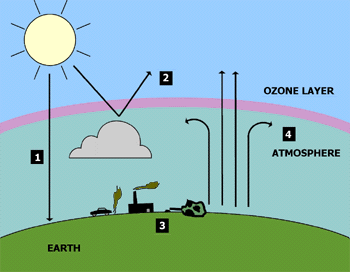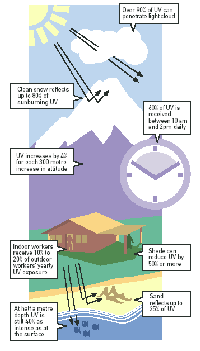
> English > Climate Encyclopaedia > Weather > more > 3. Biometeorology > - Environment and health
|
|
 |
Weather
More |
More about environmental changes and human health.
|
|
In industrialised countries, the phrase "Environmental Health" conventionally refers to the adverse effect on human health caused by exposure to specific physical and chemical agents in the local environment. The emphasis so far has been on contaminants in air, water, soil and food.
Epidemiologists and toxicologists try to quantify the effects of this exposure, either by studying human populations or by using animal experimentation.
Global environmental hazards to health include:
|
- climate change resulting from an increase in greenhouse gases in the lower atmosphere.
|
 |
 |
 |
|
Figure. 1.
1. Energy from the Sun reaches the Earth. The ozone layer shields the Earth from the Sun's harmful ultraviolet radiation.
2. About 30 percent of the solar energy is reflected back into space.
3. Burning fossil fuels and deforestation increase carbon dioxide levels in the atmosphere. Other greenhouse gases such as methane are also added to the atmosphere as a result of human activity.
4. These greenhouse gases form a "blanket" which traps heat energy coming from the surface of the Earth, thus warming the Earth.
source:http://www.texasep.org
|
|
 |
 |
|
Figure 2. UV radiation levels are influenced by: sun elevation, latitude, cloud cover, altitude, ozone, ground reflection.
source:www.who.int
Please click to enlarge!
|
|
 |
- stratospheric ozone depletion.
Effects of solar ultraviolet radiation on human health include:
skin damage - malignant melanoma, non-melanocytic cancer, sunburn
eye damage - lens opacity, acute solar retinopathy, cancer of the cornea and conjunctiva
reduction in immunity to disease and increased susceptibility to infection
direct effects - vitamin D production: prevention of rickets, possible benefit for hypertension, altered general well-being: sleep/wake cycles, mood
indirect effects - on climate, food supply, infectious disease vectors, air pollution.
|
Loss of biodiversity is occurring at a rapid rate and involves both the disappearance of useful species and genes and the weakening of various ecosystems thereby reducing the flow of nature’s life-supporting "goods and services".
|
 |
 |
 |
|
Figure 3. Even the remaining North American forests are still being cleared for new development.
source: library.thinkquest.org
Please click to enlarge!
|
|
|
|
 |
- desertification, depletion of fertile soil, groundwater and natural fisheries. This reduces the amount of food which can be grown and offsets any expected gains from genetically modified organisms, precision farming and aquaculture.
Figure 4. Left: A goat seeks food in the sparsely vegetated Sahel of Africa.
Right: Off-road vehicles significantly increase soil loss in the delicate desert environment.
source: pubs.usgs.gov
|
- various common chemical pollutants are now recognised as persistent and globally pervasive. Some appear to affect neurological, immune and reproductive systems and can no longer be considered to have specific and limited toxicity.
|
 |
 |
 |
|
Figure 5. Humans emit more and more greenhouse gases into the atmosphere Cars, trucks, home and business heating and power factories are responsible for about 98% of US carbon dioxide emissions and 18% of nitrous oxide missions.
source: www.wrh.noaa.gov
|
|
|
In addition to large-scale environmental changes, global trends within human societies have also had significant effects on human health. The prime determinant of population health in the medium-to-long term is the life-supporting capacity of the environment. Much work still needs to be done to improve our understanding of the fundamental ecological relationship between environmental conditions, climatic conditions and human health.
|
Measurement of population health
We need a measure to describe the health of population. The disease burden comprises the total amount of disease or premature death within the population. To compare burden-fractions attributable to different risk factors requires, firstly, the knowledge of the severity/disability and duration of the health deficit, and, secondly, the use of standard units of health deficit. The widely-used Disability-Adjusted Life Year (DALY) is the sum of
- years of life lost due to premature death (YLL)
- years of life lived with disability (YLD).
YLL takes into account the age at death, and YLD takes into account disease duration, age at onset, and a disability weight reflecting the severity of disease. Based on this measure, the estimated impacts of climate change in 2000 were the following in different regions.
|
| Region |
Total DALYs(1000's) |
DALY's per million population |
| Africa region |
1894 |
3071.5 |
| Eastern Mediterranean region |
768 |
1586.5 |
| Latin America and Caribbean region |
92 |
188.5 |
| South-East Asian region |
2572 |
1703.5 |
| Western Pacific region (without developed countries) |
169 |
111.4 |
| Developed countries (and Cuba) |
8 |
8.9 |
| WORLD |
5517 |
920.3 |
Examples of how diverse environmental changes affect the occurrence of various infectious diseases in humans. |
| Environmental changes |
Examples diseases |
Pathway of effect |
| Dams, canals, irrigation |
Schistosomiasis |
D Snail host habitat, human contact |
|
Malaria |
D Breeding sites for mosquitoes |
|
Helminthiasies |
D Larval contact due to moist soil |
|
River blindness |
Ñ Blackfly breeding, Ñ disease |
| Agricultural intensification |
Malaria |
Crop insecticides and D vector resistance |
|
Venezuelan haemorraghic fever |
D rodent abundance, contact |
| Urbanization, urban crowding |
Cholera |
Ñ sanitation, hygiene; D water contamination |
|
Dengue |
Water-collecting trash, D Aedes aegypti mosquito breeding sites |
|
Cutaneous leishmaniasis |
D proximity, sandfly vectors |
| Deforestation and new habitation |
Malaria |
D breeding sites and vectors, immigration of susceptible people |
|
Oropouche |
D contact, breeding of vectors |
|
Visceral leishmaniasis |
D contact with sandfly vectors |
| Reforestation |
Lyme cliease |
D tick hosts, outdoor exposure |
| Ocean warming |
red tide |
D toxic algal blooms |
| Elevated precipitation |
Rift valley fever |
D Pools for mosquito breeding |
|
Hantavirus pulmonary syndrome |
D Rodent food, habitat, abundance |
D increase Ñ reduction
|
About this page:
author: Sándor Szalai - Hungarian Meteorological Service
scientific reviewing: Dr. Ildikó Dobi Wantuch / Dr. Elena Kalmár - Hungarian Meteorological Service, Budapest
last updated: 2004 - 02 - 24
|
webpage:http://www.who.int/globalchange/climate/en/ccSCREEN.pdf
http://whqlibdoc.who.int/hq/2000/WHO_SDE_OEH_00.4.pdf
http://www.texasep.org
library.thinkquest.org
pubs.usgs.gov
http://www.who.int
http://www.wrh.noaa.gov
|
 > English > Climate Encyclopaedia > Weather > more > 3. Biometeorology > - Environment and health
> English > Climate Encyclopaedia > Weather > more > 3. Biometeorology > - Environment and health




